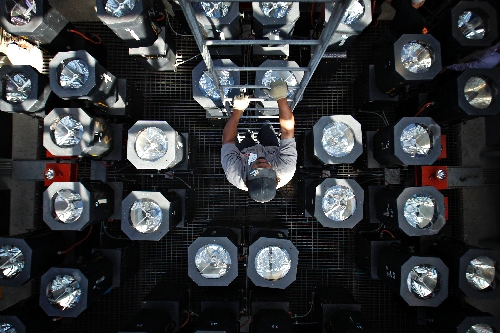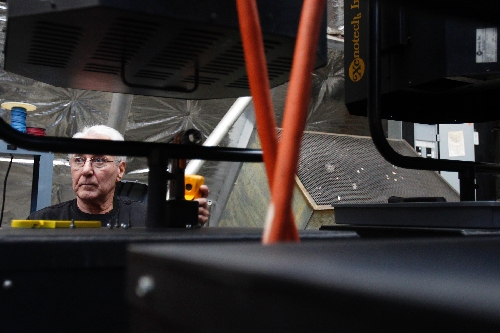Luxor light serves as beacon for millions of Las Vegas Strip visitors
For nearly 20 years, the tip of the Luxor has shone like a giant flashlight far into the night sky, serving as a beacon to every nearby creature with wings and a few aliens, too.
Well, if you believe the YouTube videos of befuddled tourists. Aliens, bugs - they might look the same in a bright, white light, especially after a few cocktails.
Since the hotel-casino opened in 1993, the Luxor Sky Beam has attained iconic status on the Strip. Everyone knows what it looks like. Even casual Vegas-philes can cite some of the beam's mythology: it's the brightest light on Earth; it can be seen from outer space. Neither "fact" is exactly true, but we'll get to that later.
Except for the lucky few who have been given a rare glimpse at the beam's inner workings, most people can only guess at what it looks like inside the tip of the pyramid. And boy, do they get it wrong, Luxor Sky Beam operators say.
There are several common misconceptions about the beam, says technician Glen Hortizuela. The main ones are that Hortizuela flips a giant light switch to turn the beam on. People also think that there is one giant light bulb screwed into the very top of the building.
Nope. The Luxor Sky Beam actually consists of 39 individual xenon lights with 7,000-watt bulbs. Collectively, the lamps sit in a room about 50 feet below the very tip of the pyramid. The room looks, surprisingly, like the backstage area of a theater with lighting panels, lights and ladders everywhere. And the switch that turns them all on? They're actually on a timer, programmed to light up right around dusk and shut off before dawn.
When it opened, the Luxor was able to claim status as the tallest structure on the Strip. Since then, the building has been dwarfed several times over. But it's still the only hotel with a sky beam.
"It's one of the city's signature things. There's nothing else in Vegas like it," says Scott Hayes, Luxor technical director and Hortizuela's boss.
A staff of two, supervised by Hayes, maintains the Sky Beam. Every day, Hortizuela and co-worker Nick Mihalic take an elevator 30 floors up, then climb a series of ladders and stairs that lead to the Luxor's light room. It's a long hike to get to the top of the Luxor so once they're up there, they try not to come down for a while.
Unfortunately, there is no bathroom up there. Nor is there a coffee pot, something that Hortizuela would love to have. The view, though, is incredible.
Hortizuela and Mihalic work during the day, as it's too hot to work around the lights when they're on. It's also too bright. Just 5 inches above the surface of the lamp, Hayes says temperatures have been measured at 500 degrees. On the worker's platform 25 feet above the lights, temperatures reach 300 degrees when the lights are on.
Of course, this wouldn't be a true Vegas attraction if some crazy stories weren't attached to it. And the Sky Beam has a few of those.
When the light was first turned on in 1993, no one imagined it would become the world's largest bug attractor. But it did. Soon after it debuted, moths flocked to the Luxor Sky Beam like, well, moths to a flame. You can see them on almost any night, flitting around in the beam.
The light technicians soon learned that, where there are moths, there are bats. They came to feast on the moths. Then the owls showed up. Apparently, bats make for a nice meal, too.
"It's a whole circle of life thing going on in there," Hayes says.
A few years ago, the YouTube videos started popping up, featuring what some thought were aliens or UFOs.
Hayes and Hortizuela laugh when asked whether the Luxor's light was attracting visitors from outer space. People are probably seeing the birds and bugs and interpreting it as something otherworldly, they say.
You're far more likely to see the Luxor's light while visiting outer space than you are to see aliens hovering above the hotel. In the 1990s, astronaut Daniel Brandenstein claimed that the Luxor's light was bright enough to wake astronauts on the space shuttle, according to a hotel spokeswoman. This is where the claim came from that you could see the light 10 miles in space.
Hayes says now, that's probably not true, because the beam gets lost in the lights of Las Vegas, which can be seen from space. The beam is visible to airline pilots about 100 miles away.
While the hotel management may have claimed that it was the brightest light on Earth, it has been dimmed considerably. It's not visible to the naked eye but the beam has been shining at half-strength since 2008. As a cost-cutting and energy-saving effort, management decided to use only half of the lamps every night, Hayes says.
He declined to say how much energy the lamps use or how much it costs the hotel. But in 1993, news reports said it used $1 million worth of electricity each year.
Not long ago, the hotel surveyed tourists, asking whether they would miss the light if it was turned off for good. The response, Hayes says, was overwhelmingly, "Leave it on."
"It is something that people associate with the Strip and Vegas," Hayes says.
Contact reporter Sonya Padgett at spadgett@reviewjournal.com or 702-380-4564. Follow @StripSonya on Twitter.































